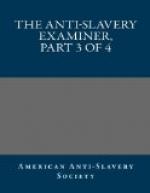“A respectable gentleman, who is now a citizen of Flemingsburg, Fleming county, Kentucky, when in the state of South Carolina, was invited by a slaveholder, to walk with him and take a view of his farm. He complied with the invitation thus given, and in their walk they came to the place where the slaves were at work, and found the overseer whipping one of them very severely for not keeping pace with his fellows—in vain the poor fellow alleged that he was sick, and could not work. The master seemed to think all was well enough, hence he and the gentleman passed on. In the space of an hour they returned by the same way, and found that the poor slave, who had been whipped as they first passed by the field of labor, was actually dead! This I have from unquestionable authority.”
Extract of a letter from a MEMBER OF CONGRESS, to the Editor of the New York American, dated Washington, Feb. 18, 1839. The name of the writer is with the Executive Committee of the American Anti-Slavery Society.
“Three days ago, the inhabitants in the vicinity of the new Patent Building were alarmed by an outcry in the street, which proved to be that of a slave who had just been knocked down with a brick-bat by his pursuing master. Prostrate on the ground, with a large gash in his head, the poor slave was receiving the blows of his master on one side, and the kicks of his master’s son on the other. His cries brought a few individuals to the spot; but no one dared to interfere, save to exclaim—You will kill him—which was met by the response, “He is mine, and I have a right to do what I please with him.” The heart-rending scene was closed from public view by dragging the poor bruised and wounded slave from the public street into his master’s stable. What followed is not known. The outcries were heard by members of Congress and others at the distance of near a quarter of a mile from the scene.
“And now, perhaps, you will ask, is not the city aroused by this flagrant cruelty and breach of the peace? I answer—not at all. Every thing is quiet. If the occurrence is mentioned at all, it is spoken of in whispers.”
From the Mobile Examiner, August 1, 1837.
“POLICE REPORT—MAYOR’S OFFICE.
Saturday morning, August 12, 1837.
“His Honor the Mayor presiding.
“Mr. MILLER, of the foundry, brought to the office this morning a small negro girl aged about eight or ten years, whom he had taken into his house some time during the previous night. She had crawled under the window of his bed room to screen herself from the night air, and to find a warmer shelter than the open canopy of heaven afforded. Of all objects of pity that have lately come to our view, this poor little girl most needs the protection of authority, and the sympathies of the charitable. From the cruelty of her master and mistress, she has been whipped, worked and starved, until she is now a breathing skeleton, hardly able to stand upon her feet.




